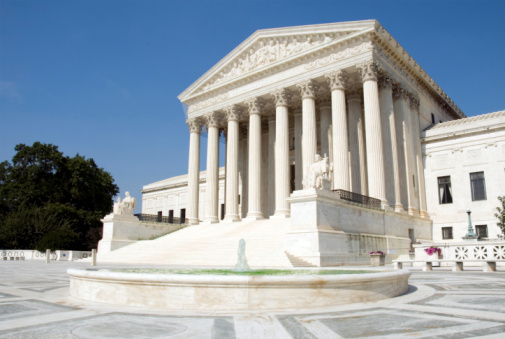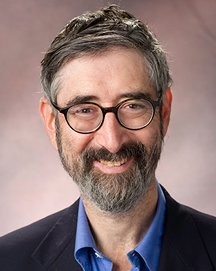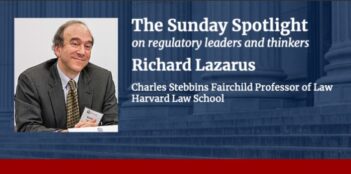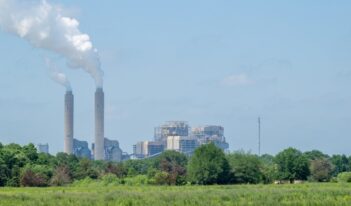
Scholar argues the impact of halting the regulation’s implementation may be small.
The United States Supreme Court did something extraordinary this month: it halted the implementation of an administrative regulation before the circuit court of appeals could decide whether the regulation is valid. There is no known precedent for this action. And yet, it is unclear what significance the stay, as it is called, will have.
The stay concerns the U.S. Environmental Protection Agency’s (EPA) Clean Power Plan, which the agency issued under the Clean Air Act. This Plan is an important part of the United States’ efforts to meet its December pledge made in Paris to lower greenhouse gas emissions by 26 to 28% from 2005 levels by 2025.
The Plan seeks to reduce greenhouse gas emissions from American electricity generators, which account for about one-third of the U.S.’s greenhouse gas emissions, by requiring States and electricity generating plants to speed the replacement of greenhouse gas-intensive coal by natural gas, and eventually by clean renewable fuels such as wind or solar.
The Plan has been challenged before the Court of Appeals for the District of Columbia Circuit by 150 different parties, but even with an expedited schedule ordered by the court, it will be months before briefs are filed and oral argument heard. The Circuit Court itself had declined to stay the rule while the case is going on. Thus, the Supreme Court’s decision to intervene at this stage is remarkable.
Yet the stay may have little significance. Originally, the stay was thought to presage an invalidation of the Plan by the Court. The death of Justice Antonin Scalia just three days after issuance of the stay means that those voting for it no longer hold the majority on the Court. Rather, the key may well be the identity of Justice Scalia’s replacement.
It was not clear even before Justice Scalia’s death that the stay reflected a view on the merits. The five Justices who voted to grant the stay are the same justices who voted for the Court’s decision last spring in Michigan v. EPA, holding that the EPA had violated the Clean Air Act in promulgating a regulation to reduce emissions of mercury and other hazardous air pollutants from electricity generators. That decision had little impact because the rule had not been stayed pending review, and so, before the Court decided the case, the vast majority of plants had already complied with the rule.
Possibly the Court wants to prevent a repetition. But the Plan lacks the same potential for making the Court’s eventual decision moot. The final deadline for compliance is not until 2032. All that would have happened for the next year or two — the likely period before the Supreme Court can decide the case if it chooses to do so — is that the States would develop plans to implement the Plan. Even this is not clear, because the EPA has said that it will be generous in giving states two additional years before submitting their plans to EPA.
So it is unclear whether the Court was seeking to preserve the status quo pending judicial review. The stay’s significance is also doubtful because it does not have that much practical importance. The stay does not prevent states from developing strategies to carry out the Plan, and at the least, the eighteen states that have intervened in court to support the Plan can be expected to do so. The stay does allow opposing states – twenty-seven have joined the suits against the Plan – to halt their efforts, but the deadline for submitting plans is, as detailed above, hardly immediate and so a delay in plan development pending judicial review will probably not have much effect.
Moreover, the Court, like King Canute, cannot stop the tide. In the short-term, federal tax incentives will do more than the Plan to increase the use of renewable energy. And, even without the Plan, drastic changes in electricity generation are coming. The EPA thinks that the Plan does nothing more than accelerate a trend from coal toward natural gas and renewables that is happening anyway, primarily for economic reasons. Already, utilities are building new natural gas-fired turbines rather than keeping coal-burning generators in existence, and utilities and others are investing in renewables, which are rapidly growing as sources of electricity. Perhaps even without the Plan, the shift to cleaner fuels will happen sooner rather than later.
The stay does, however, illustrate how controversial the rule is. Issues of statutory interpretation alone raise concerns about whether the Plan is valid.
The EPA promulgated the Clean Power Plan under section 111(d) of the Clean Air Act. Traditionally, this section can take effect when EPA sets a “new source performance standard” (NSPS) — a limit on emissions from new and modified sources — for a category of industrial plant, e.g. cement makers.
Under its traditional wording, section 111(d) applies to pollutants that are regulated by a category’s NSPS if those pollutants are not regulated under either of the Act’s major programs: the national ambient air quality standards and the hazardous air pollution program. Section 111(d) sets up a program for regulating existing sources in the NSPS category these otherwise non-regulated pollutants.
For instance, consider paper mills, which emit large quantities of total reduced sulfur. This pollutant smells like rotten eggs and it is regulated by the NSPS for such mills. But total reduced sulfur does not amount to a significant nationwide problem, and so EPA probably could not set a national ambient air quality standard for it. Nor is the pollutant so harmful that it would justify being regulated as a carcinogen under the hazardous air pollutant program. Thus, section 111(d) covers emissions of this pollutant from existing paper mills.
Under section 111(d), each state is required to submit a plan to regulate existing sources within the NSPS category that emit pollutants like total reduced sulfur. Section 111(d) says that a state is allowed to take into account, among other factors, the remaining useful life of the source, and so a state need not adopt for existing plants the same standard that applies to new plants. The EPA produces guidelines to help the states, and must either approve or disapprove each state’s plan.
Arguably, section 111(d) is merely an interstitial provision to cover a gap that would otherwise exist for pollutants that are deleterious, but not important enough to otherwise regulate under the Act. Indeed, section 111(d) has been little-used. Moreover, section 111(d) seems to give the primary role to the States in deciding what each existing source in the NSPS category must do. The Clean Power Plan, however, attempts to use section 111(d) to establish a substantial new program with EPA setting targets for the States to reach.
On its face, section 111(d) would seem to cover greenhouse gases. There are neither ambient air quality standards for or standards under the hazardous air pollutant program for these pollutants. And the EPA has recently set an NSPS for emissions of greenhouse gases from new and modified fossil-fuel fired electricity generators, thus seemingly setting the stage for regulation of greenhouse gas emissions from existing generators under 111(d).
But the EPA’s program is far from interstitial. Rather, it requires each state to formulate complex plans under which the generation mix in the state will include less use of coal, and more use of natural gas, with an eventual prominent role for renewable sources. This would be a profound transformation of an important sector of the economy.
The Supreme Court, in opinions by the late Justice Antonin Scalia, has used the principle of “no elephants in mouseholes” – for this reason, the Court has refused to find that EPA can fully regulate greenhouse emissions from all major new and modified stationary sources. The Court has said that an existing regulatory provision should not be interpreted to allow an agency to create a broad new program. Clearly this principle – if the Court is still willing to follow it now that Justice Scalia is deceased — threatens an effort as novel and comprehensive as the Clean Power Plan.
Congressional action in 1990 makes the use of section 111(d) even more controversial. In that year, Congress, as part of lengthy amendments to the Act, adopted two apparently conflicting amendments to section 111(d). One provision, originating in the Senate, made a minor conforming change that continued section 111(d)’s traditional coverage of pollutants regulated neither by ambient air quality or hazardous air pollutant standards.
But a provision originating in the House appears to take a different approach. On its face, it prohibits the use of section 111(d) to regulate any source category that is also regulated under the hazardous air pollutant program. Because the EPA has set hazardous air pollutant standards for electricity generators, the House provision would apparently forbid EPA from using section 111(d) to regulate generators.
The EPA asserts that the two amendments are actually not in conflict. The agency points out that following the literal language of the House’s provision would create a gap in regulation for harmful pollutants that are not appropriate for regulation under the national ambient air quality standards or hazardous air pollutant program, but come from sources being regulated for a hazardous air pollutant. Seeing no evidence that Congress intended such a gap — indeed, Congress was silent on what either amendment meant – the EPA concludes that the House amendment, like the Senate amendment, merely continues the traditional approach.
But the EPA’s position arguably is not easy to reconcile with the rather straightforward language of the House amendment. Moreover, it is at least plausible that Congress did intend to create a gap. The hazardous air pollutant program was extensively tightened in 1990, and Congress may have thought that a source category should not be subject both to that program and section 111(d). Indeed, this would parallel what happened with regulation of emissions of hazardous air pollutants from electricity generators. Congress specifically said in 1990, in section 112(n) of the Act, that utility emissions of hazardous air pollutants like mercury could be regulated only after a special finding by the EPA that regulation would be appropriate and necessary. Here, too, Congress was concerned about an industry that was going to be controlled sharply under newly-established parts of the Act.
The EPA and its allies say they have strong arguments in favor of the Plan on these and other points (e.g., on whether a plant can be required to take steps “outside the fenceline” to reduce its emissions). All that can be stated for sure is that the Plan’s validity is being sharply challenged. But it is far from clear that the Court’s stay will have a substantial effect.




